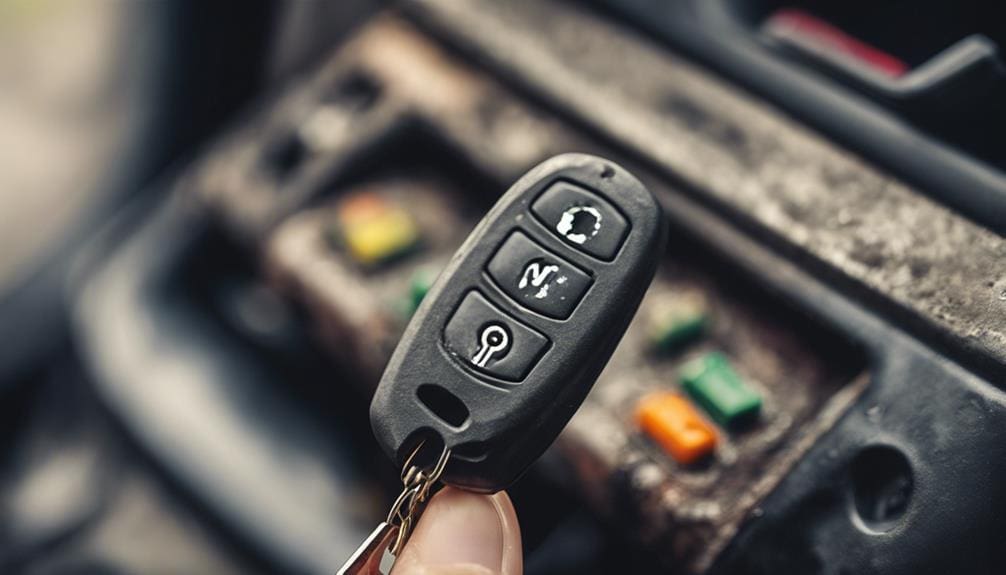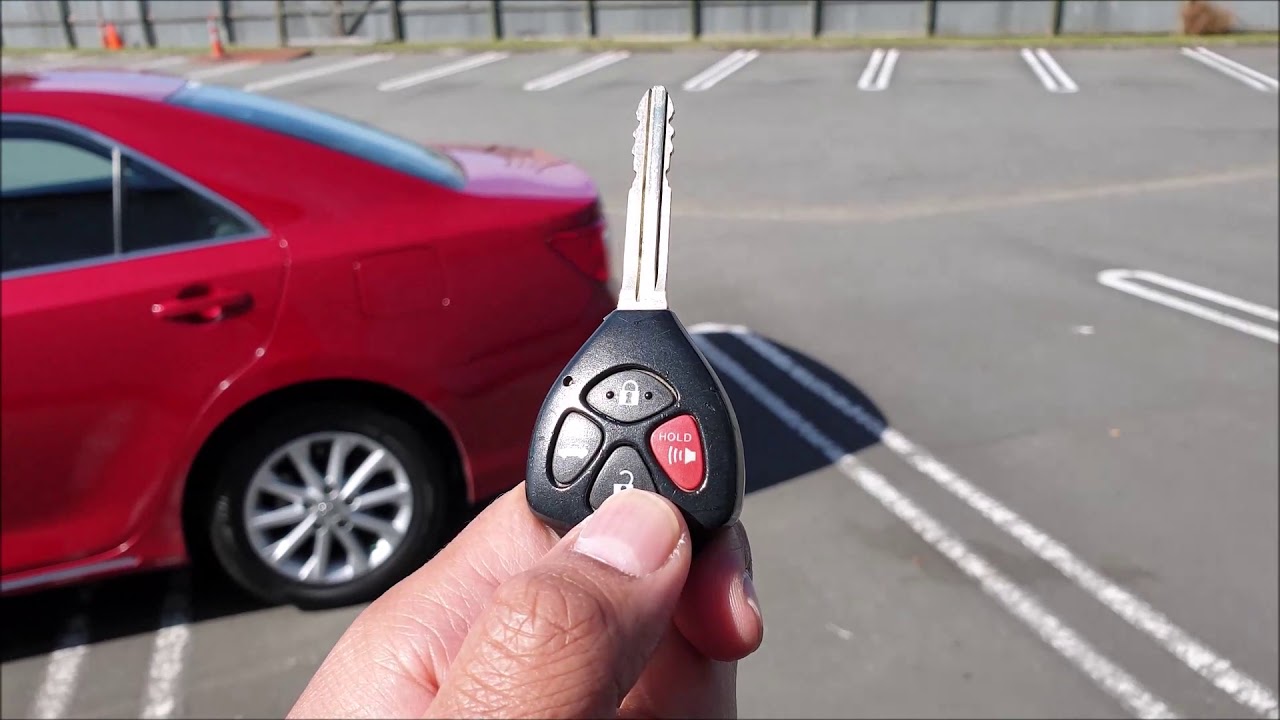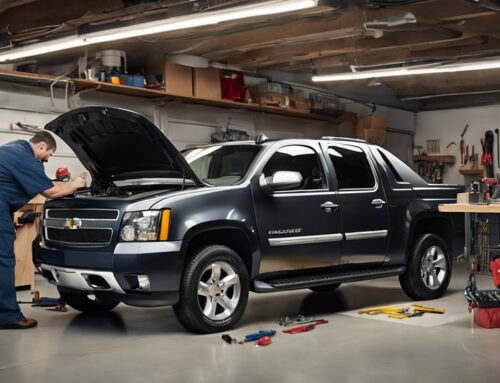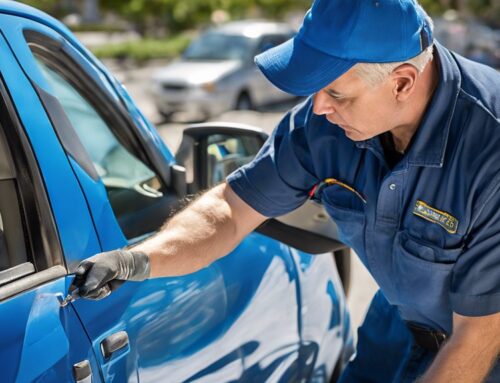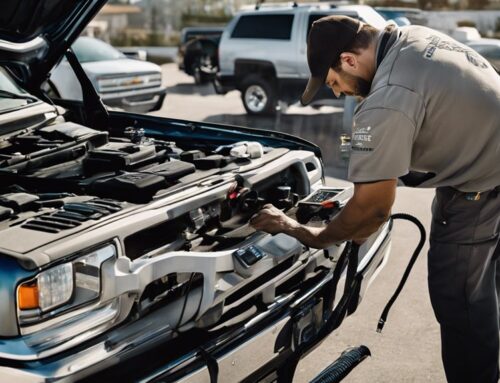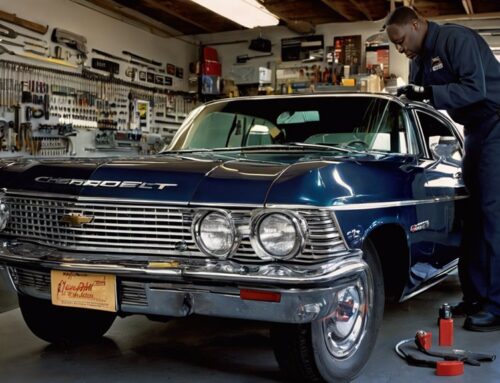Car key buttons can malfunction due to debris buildup, worn buttons, electrical issues, or signal interference. First, clean the key fob with a soft fabric and compressed air to eliminate debris. For worn buttons, examine for fractures and swap them if necessary. If electrical issues occur, inspect circuit connections, clean battery contact points, and guarantee secure attachment. Signal interference can be reduced by steering clear of metallic objects and relocating to a spacious area. Routine upkeep, such as replacing drained batteries and checking for insecure connections, ensures peak performance. For more elaborate steps to restore your key fob’s functionality.
Key Takeaways
- Debris accumulation can cause buttons to stick; clean with a soft cloth, compressed air, and mild cleaning solution.
- Worn-out buttons from frequent use may need replacing; inspect for cracks and damage to determine necessity.
- Electrical problems such as loose connections or corroded contacts can be fixed by securing connections and cleaning with rubbing alcohol.
- Signal interference from nearby electronic devices or environmental factors can disrupt key fob signals; avoid metallic objects and move to open areas.
- Battery failure hinders signal transmission; locate the battery compartment and replace it regularly with the correct type (CR2032 or CR2025).
Debris Accumulation
Debris accumulation in your key fob can lead to buttons sticking or outright malfunctioning, making it essential to remove any dirt, dust, or food particles that might hinder their proper function. To maintain your key fob’s peak performance, you’ll need to clean it regularly.
Start by examining your key fob’s exterior for any visible debris. Use a soft, dry cloth to gently wipe away dust and dirt. Pay close attention to the spaces around the buttons, as these areas are prone to trapping particles. If dirt is lodged in tight spots, employ a can of compressed air. Hold the key fob at an angle and spray short bursts of air to dislodge any stubborn particles.
Next, inspect your key fob’s buttons. Guarantee there’s no buildup around the edges that could interfere with their movement. If the buttons still feel sticky, consider using a mild electronic cleaning solution. Lightly dampen a cotton swab with the solution and gently clean around the buttons, being cautious not to oversaturate.
Regular maintenance of your key fob’s cleanliness will help prevent button malfunctions and prolong its lifespan. By taking these simple steps, you’ll secure that your key fob remains responsive and reliable.
Worn-Out Buttons
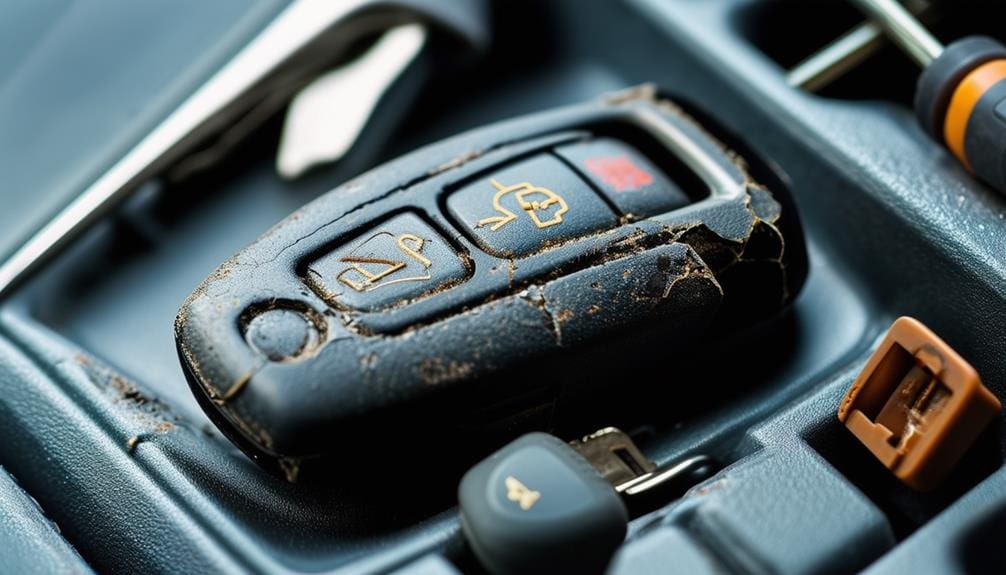
When your car key buttons face physical wear and tear, the material degrades, leading to less responsive presses. This wear can cause button contact issues, where the internal connections don’t align properly. To address this, regularly inspect the buttons and replace them if you notice any signs of deterioration.
Physical Wear and Tear
Over time, frequent use of your key fob can lead to physical wear and tear, causing the buttons to become unresponsive. Constant pressing wears down the material, and exposure to dirt and moisture accelerates deterioration. Eventually, you may notice the buttons are cracked, chipped, or no longer functional.
To address this, you can follow these steps:
- Visual Inspection: Check for any cracks or signs of physical damage on the buttons.
- Disassemble Carefully: Open the key fob using a small screwdriver. Be cautious not to damage the internal circuitry.
- Clean Thoroughly: Use a cotton swab dipped in isopropyl alcohol to clean around the buttons and the physical key slot. This removes any dirt or grime that may be causing issues.
- Button Replacement: If the buttons are beyond repair, you can order a replacement key fob case online. Transfer the internal components from the old case to the new one.
Button Contact Issues
After addressing physical wear and tear, it’s crucial to take button contact issues into account, as worn-out buttons can greatly impact your key fob’s functionality. Over time, continuous use can degrade the button contacts, making them less responsive. Additionally, dirt, debris, or moisture might infiltrate your key fob, further impairing button performance.
To tackle this issue, start by inspecting the key fob buttons for visible wear or contamination. Carefully open the key fob casing using a small screwdriver or similar tool. Once open, gently clean the button contacts with a cotton swab dipped in rubbing alcohol. This process helps remove any accumulated dirt or moisture that may be causing poor contact.
If cleaning doesn’t resolve the issue, consider the possibility that the buttons themselves might need replacement. You can find replacement button kits online or at automotive stores. Follow the kit instructions to swap out the worn buttons.
Lastly, make sure your key fob battery is in good condition. A weak battery can also contribute to poor button performance. Regular maintenance and inspection of your key fob buttons will help prevent malfunctions, ensuring dependable operation.
Electrical Problems
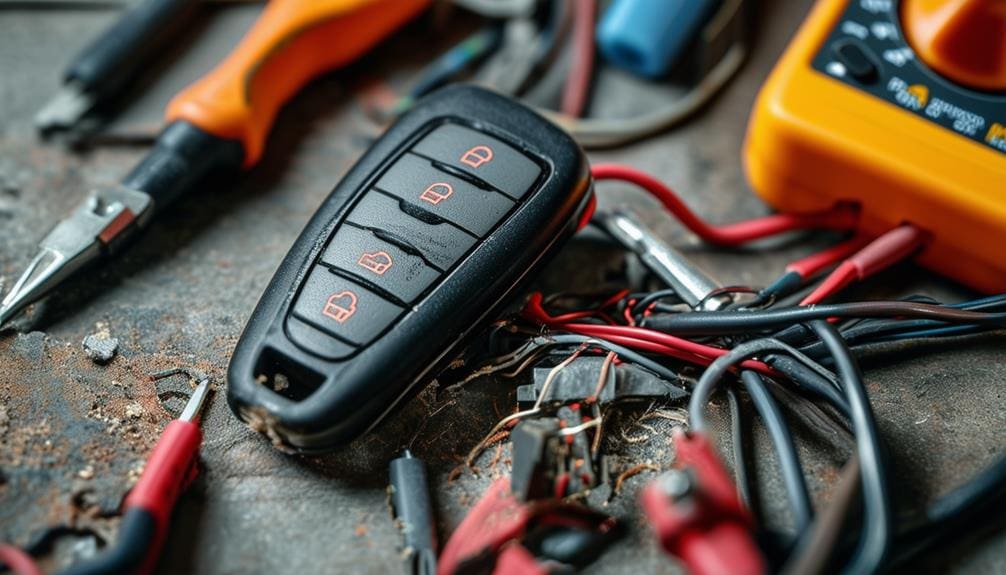
When addressing electrical problems, start by inspecting the circuit connections inside your key fob for any signs of damage or looseness. Check the battery contacts to validate they’re clean and making proper contact, as corrosion or debris can disrupt the electrical flow. Additionally, be aware of external factors like signal interference, which can prevent your key fob from communicating effectively with your vehicle.
Faulty Circuit Connections
Identifying faulty circuit connections is essential because they can disrupt the electrical signals between your key fob buttons and the car’s receiver, leading to malfunctions. Loose wiring or damaged connections within the key fob often cause these disruptions. To fix this, follow these steps:
- Start by opening your key fob using a small screwdriver. Be cautious not to damage the casing.
- Inspect the circuit board for visible signs of damage or loose connections.
- Use a magnifying glass to spot any corrosion on the contacts or circuit board. Corrosion can disrupt electrical flow.
- Moisture or water damage may cause short circuits. Look for any moisture residue or watermarks.
Next, carefully clean the circuit board using isopropyl alcohol and a soft brush. If you find loose wiring, use a soldering iron to reattach it securely. Guarantee all connections are firm and free from corrosion. Reassemble the key fob and test the buttons to confirm they’re working properly.
If these steps don’t resolve the issue, it might be best to consult professional repair services to diagnose and address the electrical problems accurately. Professionals can restore functionality by fixing or replacing damaged components within your key fob.
Battery Contact Issues
Maintaining proper battery contact is crucial for preventing key fob button malfunctions, as weak connections can disrupt the electrical flow necessary for operation. Begin by carefully opening the key fob casing to access the battery compartment. Inspect the battery terminals for any signs of corrosion, which may manifest as a white, powdery residue. Corrosion hinders the electrical connection required for the push button to operate correctly.
To clean the battery contacts, use a cotton swab dipped in isopropyl alcohol. Gently rub the swab on the terminals to eliminate any corrosion. Be thorough yet cautious to avoid damaging the components. Once cleaned, allow the contacts to dry completely before reassembling the key fob.
Next, confirm that the battery fits securely within its compartment. A loose battery can result in sporadic electrical flow, causing unreliable button performance. If the fit is not snug, consider inserting a small piece of aluminum foil between the battery and the contact to enhance the connection.
Lastly, routinely examine the battery contacts to prevent potential issues. By keeping the contacts clean and ensuring a firm fit, you’ll maintain the best functionality of your key fob’s push button.
Signal Interference Factors
Effective troubleshooting of key fob button malfunctions often involves addressing signal interference factors that can arise from various electronic and environmental sources. Signal interference is a common culprit, and understanding the specifics can help you resolve the issue.
First, identify any nearby electronic gadgets. Cell phones, other key fobs, and even some household gadgets emit frequencies that can disrupt your key fob’s signal. Keep your key fob away from such gadgets.
Next, consider electrical problems. Interference from radio frequencies or a weak transmitter battery can also lead to malfunction. Confirm your key fob’s battery is fresh and properly installed.
Environmental factors can also play a part. Structures like buildings or even adverse weather conditions can weaken the signal. If you’re in a crowded area, try moving to a more open space to see if the signal improves.
Lastly, avoid keeping metallic objects near your key fob. Items such as coins or keys can block or interfere with the signal transmission.
Battery Failure
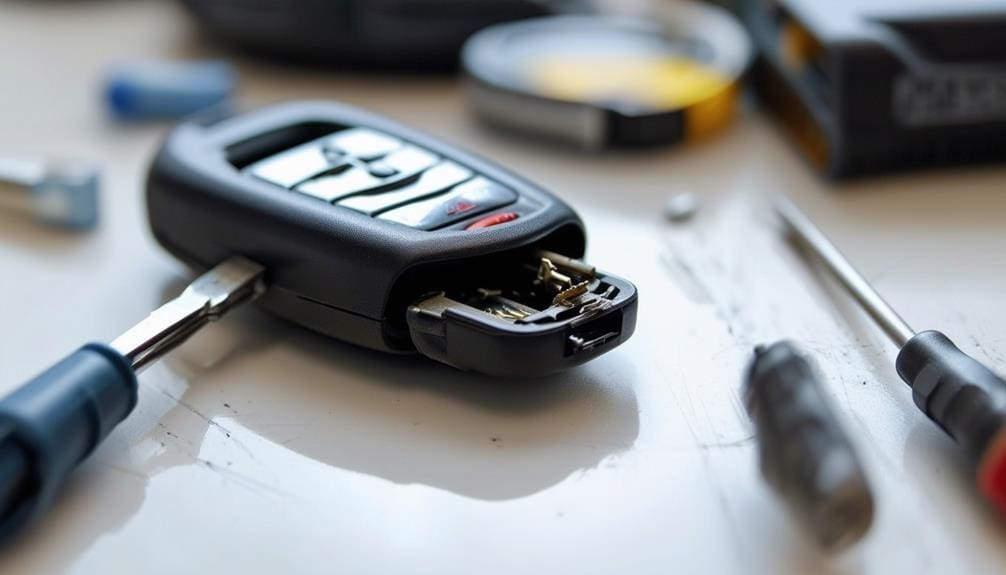
One of the most common reasons for car key button malfunctions is a depleted battery, which can hinder the key fob from sending a signal to the car’s receiver. When the battery is low, the key fob struggles to communicate with the car’s ignition systems, resulting in unresponsive buttons.
To fix this issue, first, locate the battery compartment on your key fob. Typically, you’ll find a small screw or a sliding cover on the back. Use a screwdriver or your fingernail to open it carefully. Once open, take note of the battery type—usually a CR2032 or CR2025 lithium coin cell.
Remove the old battery and insert the new one, making sure the positive side faces the correct direction, as indicated in the compartment. Close the cover securely and test the key fob by pressing the buttons to see if they work. If the buttons are responsive, you’ve successfully resolved the issue.
To avoid future malfunctions, regularly check your key fob’s battery status and replace it as needed. Ignoring a low battery can lead to complete button failure, potentially leaving you locked out of your vehicle. Regular maintenance guarantees reliable use and prevents unexpected malfunctions.
Cleaning the Key Fob
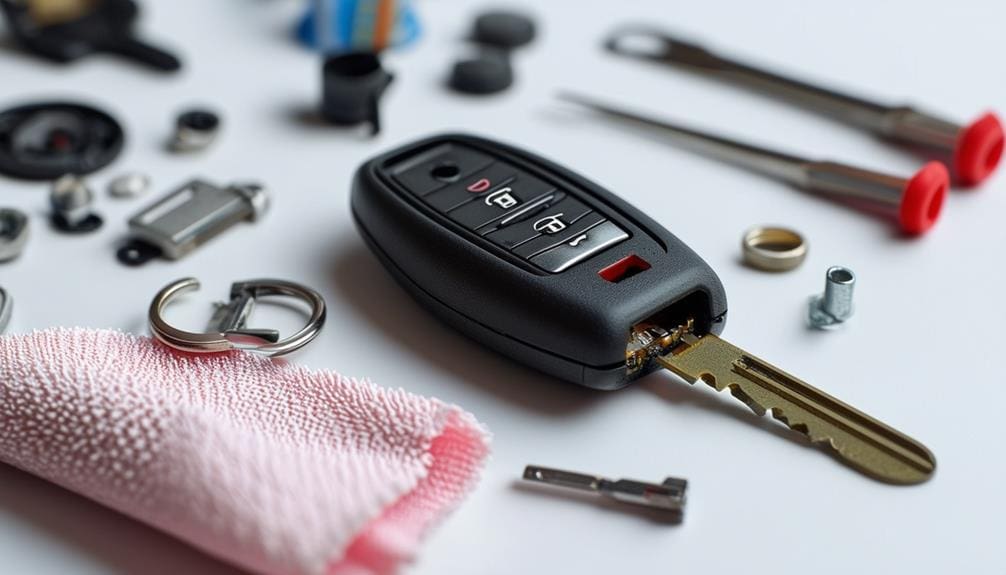
After addressing battery issues, another common cause of car key button malfunctions is the accumulation of dirt and debris, which can interfere with the key fob’s functionality. Cleaning your key fob is crucial for maintaining its operation, and it’s simpler than you might anticipate.
First, gather your cleaning supplies. You’ll need a soft cloth, mild soap, and a cotton swab dipped in rubbing alcohol. Avoid using harsh chemicals or excessive moisture, as these can harm the key fob.
Begin by gently wiping the key fob with the soft cloth and mild soap. This will eliminate surface dirt and debris. Make sure to remove any sticky residue that might hinder the buttons’ proper function.
Next, use a cotton swab dipped in rubbing alcohol to clean around the buttons. This will help reach any hard-to-access areas and guarantee a thorough cleaning.
Here’s a quick summary of the steps:
- Soft cloth and mild soap: Remove surface dirt.
- Avoid harsh chemicals: Prevent damage.
- Gently wipe buttons: Eliminate sticky residue.
- Cotton swab with rubbing alcohol: Clean hard-to-reach areas.
If you need any cleaning supplies, your local Auto Zone should have what you need. Keeping your key fob clean can prevent malfunctions and guarantee smooth operation.
Replacing Worn Buttons
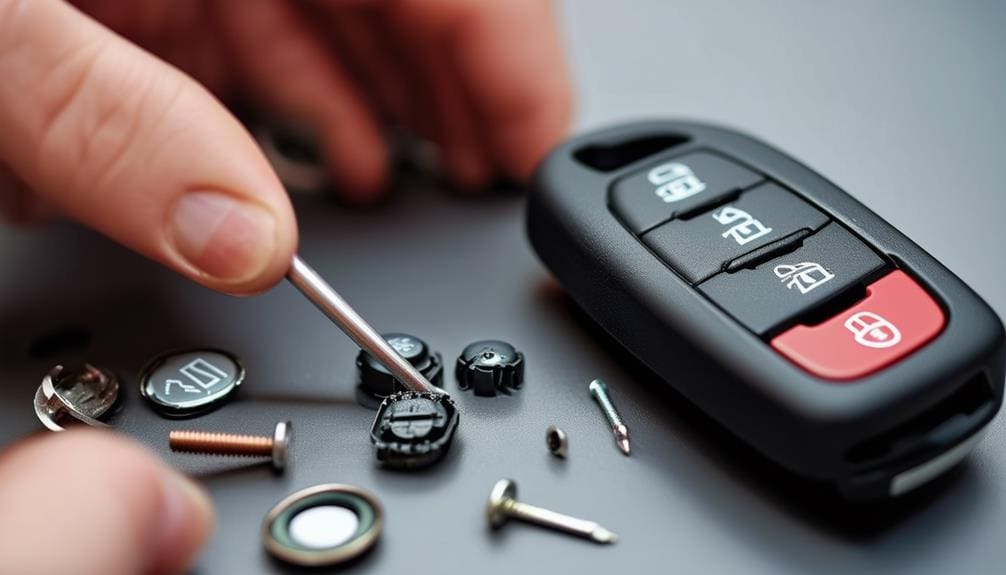
When the buttons on your key fob start to wear out, replacing them can restore functionality and prevent further issues. Worn buttons often become unresponsive or hard to press, leading to difficulty when you try to open your car. Fortunately, you can find replacement button kits that allow you to fix this issue yourself, saving time and money.
Here’s a step-by-step guide to replacing those worn buttons:
- Disassemble the Key Fob: Use a small screwdriver to carefully pry open the key fob.
- Remove Old Buttons: Gently lift out the worn buttons. They may be attached with adhesive, so take your time.
- Install New Buttons: Place the new buttons in the same positions, ensuring they fit snugly and are aligned correctly.
| Step | Tool Needed | Time Required |
|---|---|---|
| Disassemble the Key Fob | Small screwdriver | 5 minutes |
| Remove Old Buttons | Tweezers (optional) | 3 minutes |
| Install New Buttons | Replacement button kit | 7 minutes |
Proper installation of the new buttons can extend your key fob’s lifespan and prevent future malfunctions. This DIY solution is both cost-effective and practical, ensuring you can always open your car without hassle.
Checking Electrical Connections
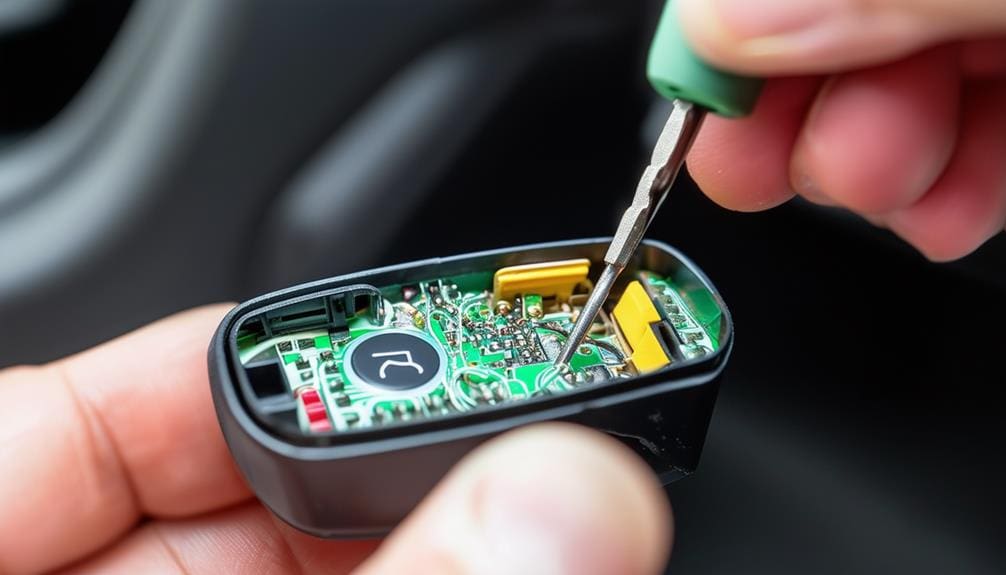
Maintaining your key fob’s electrical connections are secure and free from corrosion is crucial for preserving its functionality. Loose or corroded connections can hinder the key fob from working correctly and, consequently, enable you to start your vehicle.
First, open the key fob casing and inspect the circuit board for any visible damage or signs of wear. Examine closely the electrical connections and contacts.
- Damaged Circuit Board: Look for cracks or burnt areas.
- Corroded Contacts: Check for a green or white powdery buildup.
- Loose Connections: Wiggle the components slightly to see if any parts are loose.
- Continuity Test: Use a multimeter to test if the connections are intact.
If you notice corrosion, clean the contacts using rubbing alcohol and a soft cloth. Gently rub the affected areas until the corrosion is gone. After cleaning, use the multimeter again to verify the connections are now continuous. If the connections are still problematic, they might be beyond repair. At this point, you should consider replacing the key fob or seeking professional help to avoid further issues. Properly maintained electrical connections will guarantee your key fob remains reliable, enabling you to start your car without any hitches.
Replacing the Battery
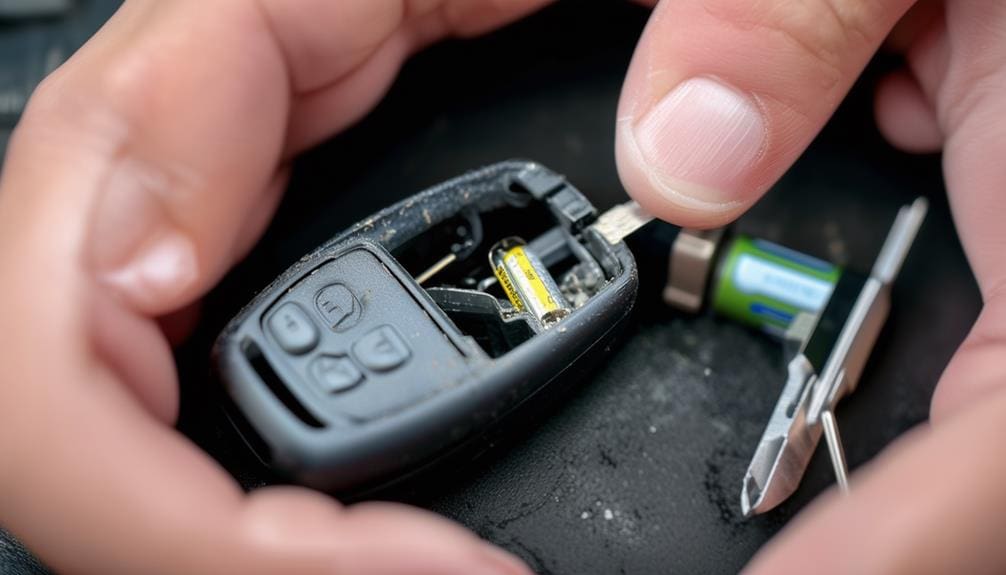
If your key fob‘s electrical connections are intact but you still experience issues, it’s time to consider replacing the battery. There’s often a simple explanation for malfunctions: a depleted battery. Most key fobs use CR2032 or CR2025 batteries, which are readily available in stores or online. To begin, you’ll need a small flathead screwdriver or a similar tool.
First, locate the seam or notch on your key fob. Gently insert the screwdriver and twist to open the case. Be cautious to avoid damaging internal components. Once opened, identify the battery, which is typically a coin-cell type. Note the battery model number—usually imprinted on the battery itself.
Carefully remove the old battery, paying attention to the orientation (positive and negative sides). Insert the new battery in the same orientation. Snap the key fob case back together, ensuring it’s securely closed. Test the key fob to confirm functionality.
A low battery can cause intermittent functioning or complete failure of the buttons. Regularly checking and replacing the battery can preempt unexpected malfunctions. This simple DIY fix often restores your key fob’s full functionality, saving you from potential inconvenience.
Frequently Asked Questions
Why Are the Buttons on My Car Keys Not Working?
Your car key buttons might not work due to button corrosion from moisture, dirt and debris accumulation, internal circuitry issues, or aging batteries. Inspect and clean the fob, replace batteries, or consult a professional for internal repairs.
Why Is My Car Not Responding to the Keys?
Check your key battery first. If it’s depleted, replace it. Inspect the buttons for damage or debris, and look for internal circuitry issues. Confirm no electronic interference and verify the car’s receiver system is functioning properly.
How Do You Know if Your Key Needs to Be Reprogrammed?
If your key fob’s acting up like a stubborn mule, it might need key reprogramming. Look for signs like the key not opening or starting the car. Follow your owner’s manual or consult a professional for steps.
How Do You Fix a Keyless Car Key?
To fix a keyless car key, first inspect for visible damage. Disassemble the fob to check internal components. If unsuccessful, try reprogramming methods. Seek professional help or source a replacement key fob from auto stores or dealers.
Conclusion
Simply put, understanding the root causes of car key button malfunctions—whether it’s debris accumulation, worn-out buttons, electrical problems, or battery failure—puts you in the driver’s seat. By methodically cleaning the key fob, replacing worn buttons, checking electrical connections, and swapping out the battery, you’ll be back on the road in no time. Don’t let minor issues steer your journey; tackle them head-on with these straightforward steps and enjoy a smooth ride.

